
上海交通大学学报(医学版) ›› 2024, Vol. 44 ›› Issue (12): 1570-1578.doi: 10.3969/j.issn.1674-8115.2024.12.010
收稿日期:2024-05-03
接受日期:2024-09-30
出版日期:2024-12-28
发布日期:2024-12-28
通讯作者:
徐 健,电子信箱:sonia0616@sjtu.edu.cn。作者简介:徐祖婧(1999—),女,硕士生;电子信箱:tzxuzujing@163.com。
基金资助:
XU Zujing1,2( ), JIANG Yining1,2, XU Jian1,2,3(
), JIANG Yining1,2, XU Jian1,2,3( )
)
Received:2024-05-03
Accepted:2024-09-30
Online:2024-12-28
Published:2024-12-28
Contact:
XU Jian, E-mail: sonia0616@sjtu.edu.cn.Supported by:摘要:
目的·分析出生前母体重(类)金属复合暴露与子代认知和气质发育的相关性。方法·利用2010—2012年在上海开展的前瞻性出生队列,在妊娠28~36周采集孕妇静脉血,检测静脉血重(类)金属浓度。在幼儿24~36月龄时,使用格塞尔发育量表和幼儿气质量表分别评估幼儿的认知和气质发育。通过问卷及医院病历系统收集孕妇及幼儿的基本信息。使用贝叶斯核机器回归(Bayesian kernel machine regression,BKMR)模型评估出生前母体重(类)金属复合暴露对幼儿认知和气质发育的影响。结果·最终共纳入139对信息完整的母婴。入组时孕妇年龄为(29.39±3.41)岁,婴儿出生体质量为(3.47±0.42)kg,女性占59.71%,随访时幼儿月龄为(32.91±2.69)个月。根据以往研究证据和多元线性回归模型筛选出和幼儿认知和气质发展可能有关联的4种重(类)金属元素,分别为铬(Cr)、锰(Mn)、砷(As)和铅(Pb)。出生前母体静脉血Mn、Pb、As、Cr的浓度中位数分别为3.32、3.60、2.03、1.78 μg/dL。BKMR模型分析发现,矫正相关混杂因素后,当4种重(类)金属的整体浓度高于第50个百分位时,随着重(类)金属整体浓度的增加,幼儿的精细动作发育商呈下降趋势,且幼儿气质量表的适应性、坚持性和反应阈维度得分均呈下降趋势。其中出生前母体Mn暴露对幼儿精细动作发育影响的贡献最大[后验包含概率(posterior inclusion probabilities,PIP)=0.617],As暴露对幼儿坚持性维度影响的贡献最大(PIP=0.656),Cr暴露对幼儿反应阈维度影响的贡献最大(PIP=0.447),4种重(类)金属暴露对幼儿适应性维度影响的贡献相近。结论·出生前母体重(类)金属(Mn、As、Pb、Cr)复合暴露与幼儿的精细动作发育和气质的适应性、坚持性和反应阈维度发育之间可能存在相关性;尤其要重视Mn暴露与幼儿精细动作发育之间,以及As和Cr暴露与幼儿气质发育之间的关系。
中图分类号:
徐祖婧, 江怡宁, 徐健. 出生前母体重(类)金属复合暴露与子代认知和气质发育的相关性研究[J]. 上海交通大学学报(医学版), 2024, 44(12): 1570-1578.
XU Zujing, JIANG Yining, XU Jian. Relationship between prenatal mixed heavy metal/metalloid exposure and offspring cognitive and temperament development[J]. Journal of Shanghai Jiao Tong University (Medical Science), 2024, 44(12): 1570-1578.
| Characteristic | Value |
|---|---|
| Maternal age/year | 29.39±3.41 |
| Maternal education level/n(%) | |
| Senior high school or below | 16 (11.50) |
| University or college | 105 (75.54) |
| Postgraduate | 18 (12.95) |
| Marital status/n(%) | |
| Married | 134 (96.40) |
| Single | 5 (3.60) |
| Occupation/n(%) | |
| Professional and technical personnel | 45 (32.37) |
| Administrative or management personnel | 30 (21.58) |
| Commercial personnel | 25 (17.99) |
| Others | 39 (28.06) |
| Family monthly income/n(%) | |
| <2 000 yuan | 6 (4.32) |
| 2 000‒5 000 yuan | 37 (26.62) |
| 5 000‒10 000 yuan | 54 (38.85) |
| >10 000 yuan | 42 (30.21) |
| Birth weight/kg | 3.47±0.42 |
| Gestational age/week | 39.27±1.36 |
| Child gender/n(%) | |
| Male | 56 (40.29) |
| Female | 83 (59.71) |
| Child age/month | 32.91±2.69 |
| DQ of GDS/score | |
| Gross motor | 108.36±11.05 |
| Fine motor | 100.47±13.32 |
| Language | 111.48±12.40 |
| Adaptive | 114.23±8.81 |
| Personal-social | 105.38±11.01 |
| Score of TTS/score | |
| Activity | 3.23±0.57 |
| Rhythm | 2.63±0.57 |
| Withdrawal | 2.94±0.77 |
| Adaptability | 2.90±0.58 |
| Reaction | 3.85±0.60 |
| Mood | 2.66±0.63 |
| Persistence | 2.86±0.66 |
| Attention | 3.72±0.53 |
| Threshold | 3.89±0.75 |
| Heavy metal/metalloid level/(μg·dL-1) | |
| Mn | 3.32 (2.24, 4.63) |
| Pb | 3.60 (2.55, 4.35) |
| As | 2.03 (1.01, 3.35) |
| Cr | 1.78 (0.77, 2.52) |
表1 研究对象的人口学特征及临床特征
Tab 1 Demographic and clinical characteristics of participants
| Characteristic | Value |
|---|---|
| Maternal age/year | 29.39±3.41 |
| Maternal education level/n(%) | |
| Senior high school or below | 16 (11.50) |
| University or college | 105 (75.54) |
| Postgraduate | 18 (12.95) |
| Marital status/n(%) | |
| Married | 134 (96.40) |
| Single | 5 (3.60) |
| Occupation/n(%) | |
| Professional and technical personnel | 45 (32.37) |
| Administrative or management personnel | 30 (21.58) |
| Commercial personnel | 25 (17.99) |
| Others | 39 (28.06) |
| Family monthly income/n(%) | |
| <2 000 yuan | 6 (4.32) |
| 2 000‒5 000 yuan | 37 (26.62) |
| 5 000‒10 000 yuan | 54 (38.85) |
| >10 000 yuan | 42 (30.21) |
| Birth weight/kg | 3.47±0.42 |
| Gestational age/week | 39.27±1.36 |
| Child gender/n(%) | |
| Male | 56 (40.29) |
| Female | 83 (59.71) |
| Child age/month | 32.91±2.69 |
| DQ of GDS/score | |
| Gross motor | 108.36±11.05 |
| Fine motor | 100.47±13.32 |
| Language | 111.48±12.40 |
| Adaptive | 114.23±8.81 |
| Personal-social | 105.38±11.01 |
| Score of TTS/score | |
| Activity | 3.23±0.57 |
| Rhythm | 2.63±0.57 |
| Withdrawal | 2.94±0.77 |
| Adaptability | 2.90±0.58 |
| Reaction | 3.85±0.60 |
| Mood | 2.66±0.63 |
| Persistence | 2.86±0.66 |
| Attention | 3.72±0.53 |
| Threshold | 3.89±0.75 |
| Heavy metal/metalloid level/(μg·dL-1) | |
| Mn | 3.32 (2.24, 4.63) |
| Pb | 3.60 (2.55, 4.35) |
| As | 2.03 (1.01, 3.35) |
| Cr | 1.78 (0.77, 2.52) |
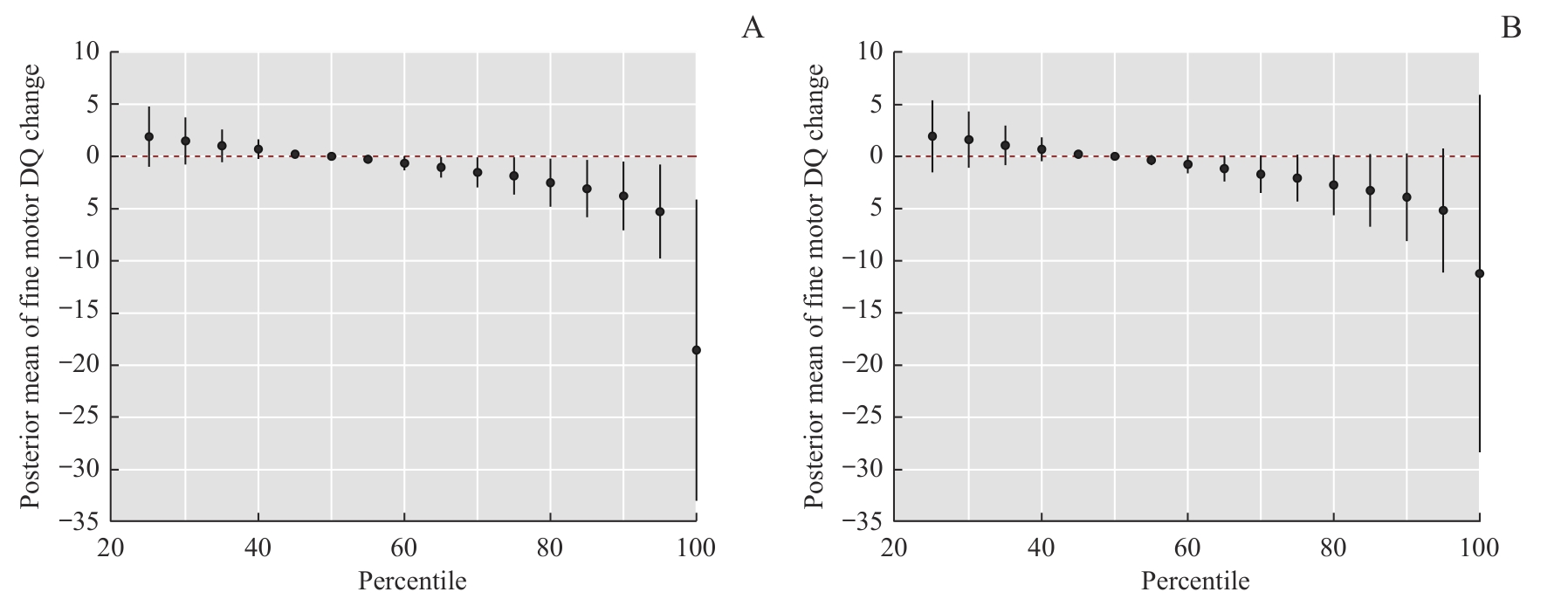
图1 通过BKMR模型分析出生前母体4种重(类)金属复合暴露对幼儿精细动作发育的总效应Note: The overall concentration of the four heavy metals/metalloid (Mn, Cr, As, and Pb) at the P50 level was used as the reference (dashed lines). A. Without adjustment for confounders. B. After adjusting for maternal age, maternal education, gestational age, child age, and child gender.
Fig 1 Total effect of prenatal maternal exposure to a combination of four heavy metals/metalloid on the fine motor development of children by the BKMR model
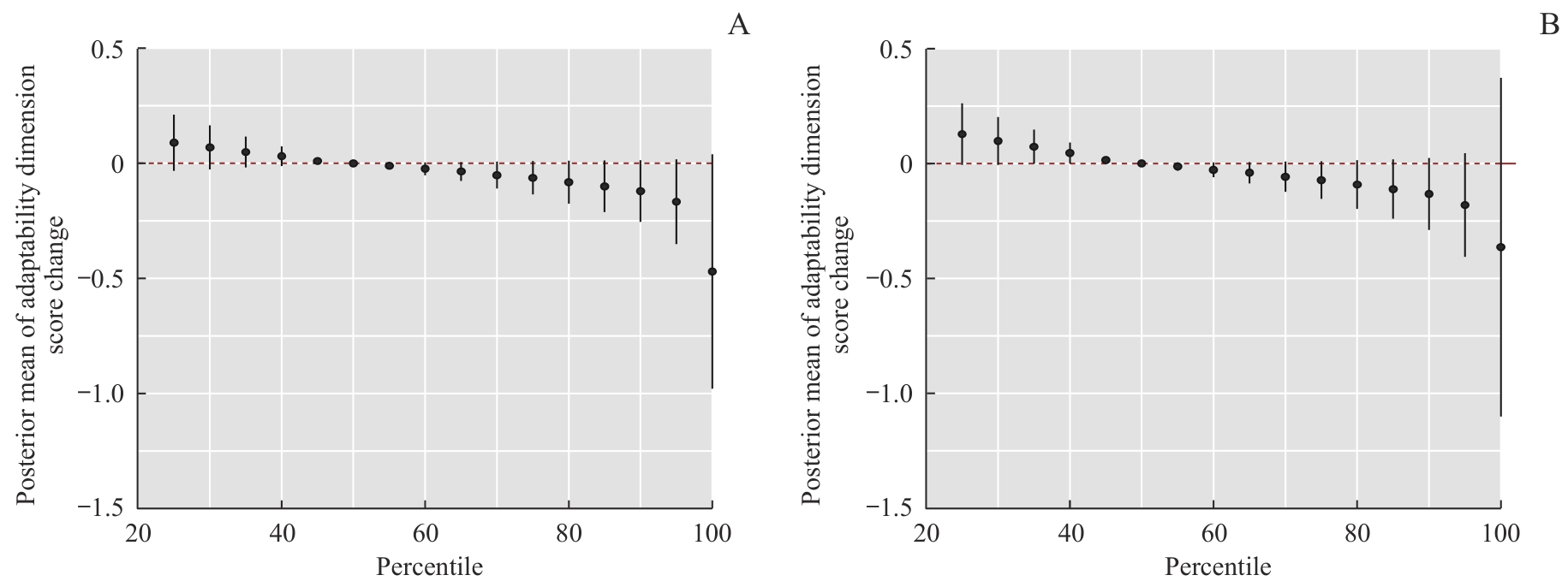
图2 通过BKMR模型分析出生前母体4种重(类)金属复合暴露对幼儿适应性维度的总效应Note: The overall concentration of the four heavy metals/metalloid (Mn, Cr, As, and Pb) at the P50 level was used as the reference (dashed lines). A. Without adjustment for confounders. B. After adjusting for maternal age, maternal education, gestational age, child age, and child gender.
Fig 2 Total effect of prenatal maternal exposure to a combination of four heavy metals/metalloid on the adaptive dimension of the children by the BKMR model
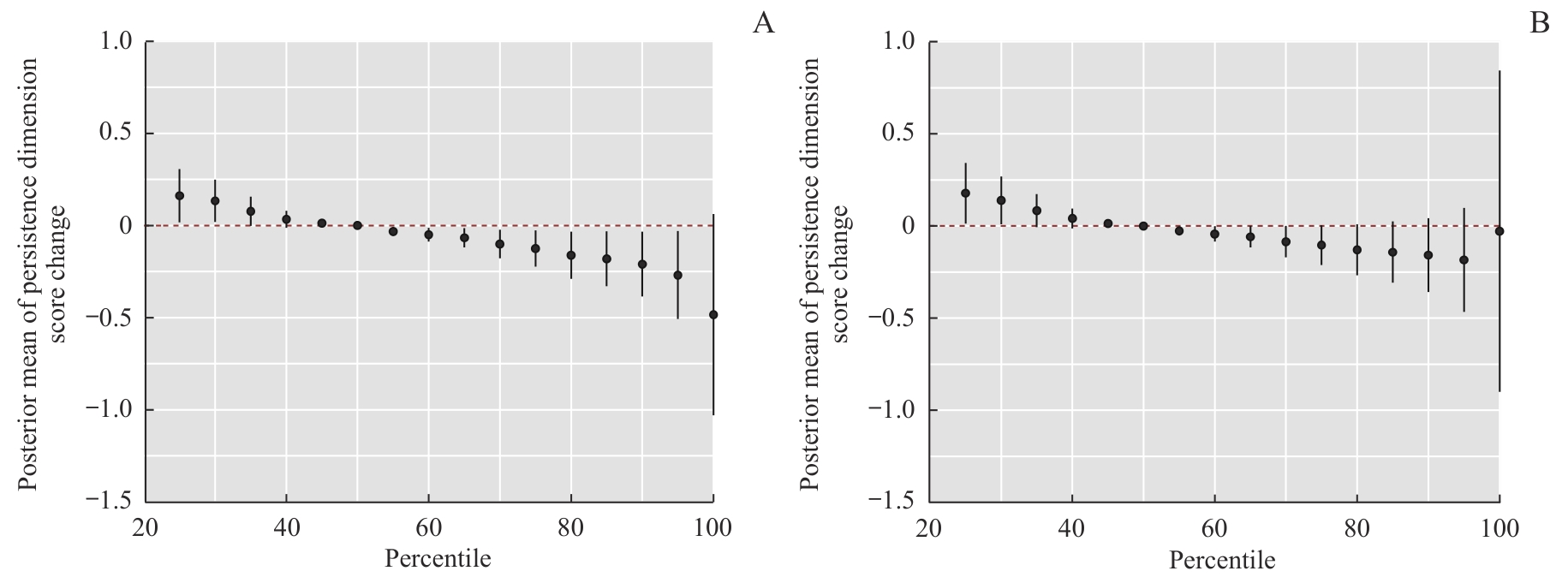
图3 通过BKMR模型分析出生前母体4种重(类)金属复合暴露对幼儿坚持性维度的总效应Note: The overall concentration of the four heavy metals/metalloid (Mn, Cr, As, and Pb) at the P50 level was used as the reference (dashed lines). A. Without adjustment for confounders. B. After adjusting for maternal age, maternal education, gestational age, child age, and child gender.
Fig 3 Total effect of prenatal maternal exposure to a combination of four heavy metals/metalloid on the persistence dimension of the children by the BKMR model
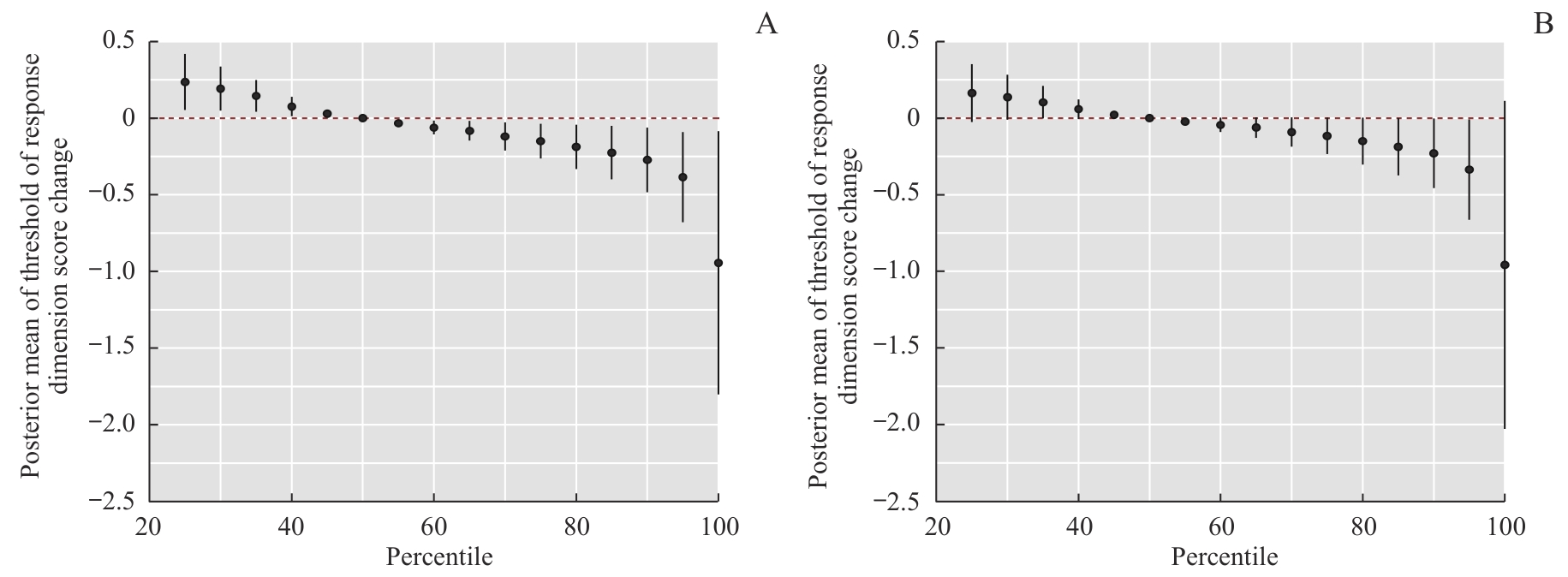
图4 通过BKMR模型分析出生前母体4种重(类)金属复合暴露对幼儿反应阈维度的总效应Note: The overall concentration of the four heavy metals/metalloid (Mn, Cr, As, and Pb) at the P50 level was used as the reference (dashed lines). A. Without adjustment for confounders. B. After adjusting for maternal age, maternal education, gestational age, child age, and child gender.
Fig 4 Total effect of prenatal maternal exposure to a combination of four heavy metals/metalloid on the threshold of response dimension of the children by the BKMR model
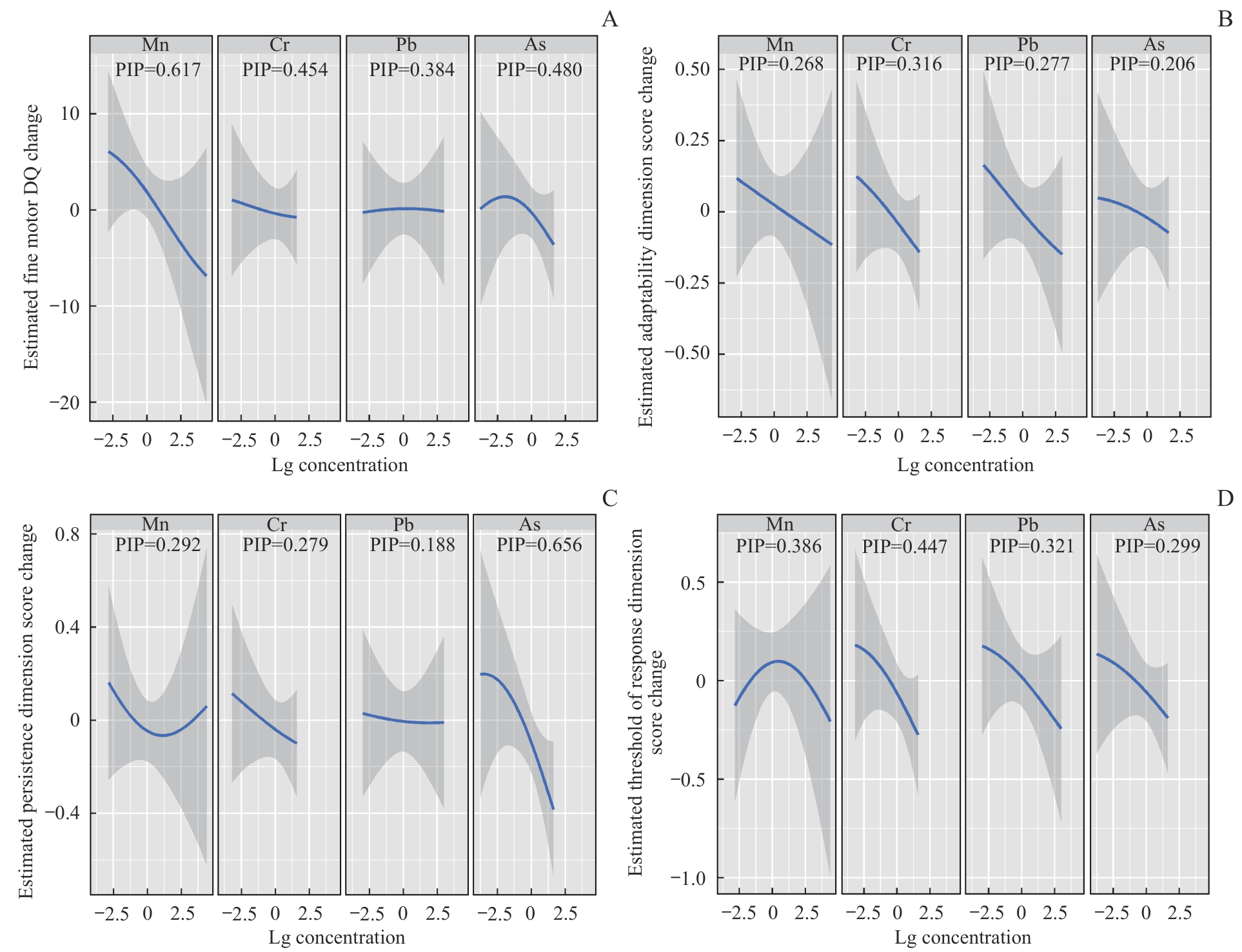
图5 基于BKMR模型分析出生前母体4种重(类)金属暴露对幼儿认知和气质发育影响的主导性Note: The models were adjusted for maternal age, maternal education, gestational age, child age, and child sex. The impact of prenatal maternal exposure to various heavy metals/metalloid on the changes in fine motor DQ (A), and adaptability (B)/persistence (C)/threshold of response (D) dimension scores across different exposure levels was assessed. The figures illustrated the associations between the concentration of a specific heavy metal/metalloid and changes in the DQ value or dimension scores, while the concentration levels of the other three were fixed at the 50th percentile.
Fig 5 Analyses of the dominant effects of prenatal maternal exposure to the four heavy metals/metalloid on cognitive and temperament development in young children based on the BKMR model
| 1 | WITKOWSKA D, SŁOWIK J, CHILICKA K. Heavy metals and human health: possible exposure pathways and the competition for protein binding sites[J]. Molecules, 2021, 26(19): 6060. |
| 2 | DÓREA J G. Exposure to environmental neurotoxic substances and neurodevelopment in children from Latin America and the Caribbean[J]. Environ Res, 2021, 192: 110199. |
| 3 | WANG Y H, WANG Y Q, YAN C H. Gender differences in trace element exposures with cognitive abilities of school-aged children: a cohort study in Wujiang city, China[J]. Environ Sci Pollut Res Int, 2022, 29(43): 64807-64821. |
| 4 | JIA Z X, ZHANG H L, YU L, et al. Prenatal lead exposure, genetic factors, and cognitive developmental delay[J]. JAMA Netw Open, 2023, 6(10): e2339108. |
| 5 | GUO J Q, WU C H, ZHANG J M, et al. Prenatal exposure to mixture of heavy metals, pesticides and phenols and IQ in children at 7 years of age: the SMBCS study[J]. Environ Int, 2020, 139: 105692. |
| 6 | KADAWATHAGEDARA M, MUCKLE G, QUÉNEL P, et al. Infant neurodevelopment and behavior in Guadeloupe after lead exposure and Zika maternal infection during pregnancy[J]. Neurotoxicology, 2023, 94: 135-146. |
| 7 | LIU J Y, MARTIN L J, DINU I, et al. Interaction of prenatal bisphenols, maternal nutrients, and toxic metal exposures on neurodevelopment of 2-year-olds in the APrON cohort[J]. Environ Int, 2021, 155: 106601. |
| 8 | SKOGHEIM T S, WEYDE K V F, ENGEL S M, et al. Metal and essential element concentrations during pregnancy and associations with autism spectrum disorder and attention-deficit/hyperactivity disorder in children[J]. Environ Int, 2021, 152: 106468. |
| 9 | STROUSTRUP A, HSU H H, SVENSSON K, et al. Toddler temperament and prenatal exposure to lead and maternal depression[J]. Environ Health, 2016, 15(1): 71. |
| 10 | BOBB J F, VALERI L, CLAUS HENN B, et al. Bayesian kernel machine regression for estimating the health effects of multi-pollutant mixtures[J]. Biostatistics, 2015, 16(3): 493-508. |
| 11 | ZHANG Y Q, DONG T Y, HU W Y, et al. Association between exposure to a mixture of phenols, pesticides, and phthalates and obesity: comparison of three statistical models[J]. Environ Int, 2019, 123: 325-336. |
| 12 | TAN Y X, FU Y Y, YAO H J, et al. Relationship between phthalates exposures and hyperuricemia in U.S. general population, a multi-cycle study of NHANES 2007‒2016[J]. Sci Total Environ, 2023, 859(Pt 1): 160208. |
| 13 | ZHAN W Q, QIU W, AO Y, et al. Environmental exposure to emerging alternatives of per- and polyfluoroalkyl substances and polycystic ovarian syndrome in women diagnosed with infertility: a mixture analysis[J]. Environ Health Perspect, 2023, 131(5): 57001. |
| 14 | YAO Q, VINTURACHE A, LEI X N, et al. Prenatal exposure to per- and polyfluoroalkyl substances, fetal thyroid hormones, and infant neurodevelopment[J]. Environ Res, 2022, 206: 112561. |
| 15 | JIANG Y Q, WEI Y Y, GUO W H, et al. Prenatal titanium exposure and child neurodevelopment at 1 year of age: a longitudinal prospective birth cohort study[J]. Chemosphere, 2023, 311(Pt 1): 137034. |
| 16 | 洪琦, 周胜利, 姚凯南, 等. 幼儿气质量表的应用研究[J]. 中国儿童保健杂志, 2001, 9(3): 151-153. |
| HONG Q, ZHOU S L, YAO K N, et al. The assessment of Toddler Temperament Scale[J]. Chinese Journal of Child Health Care, 2001, 9(3): 151-153. | |
| 17 | GIBBS M V, REEVES D, CUNNINGHAM C C. The application of temperament questionnaires to a British sample: issues of reliability and validity[J]. J Child Psychol Psychiatry, 1987, 28(1): 61-77. |
| 18 | ETTINGER A S, WENGROVITZ A G, PORTIE C, et al. Guidelines for the identification and management of lead exposure in pregnant and lactating women[S/OL]. Atlanta: U.S. Department of Health and Human Services, 2010[2024-09-19]. https://stacks.cdc.gov/view /cdc/147837. |
| 19 | ZINIA S S, YANG K H, LEE E J, et al. Effects of heavy metal exposure during pregnancy on birth outcomes[J]. Sci Rep, 2023, 13(1): 18990. |
| 20 | AL-SALEH I, SHINWARI N, MASHHOUR A, et al. Birth outcome measures and maternal exposure to heavy metals (lead, cadmium and mercury) in Saudi Arabian population[J]. Int J Hyg Environ Health, 2014, 217(2/3): 205-218. |
| 21 | CLAUS HENN B, SCHNAAS L, ETTINGER A S, et al. Associations of early childhood manganese and lead coexposure with neurodevelopment[J]. Environ Health Perspect, 2012, 120(1): 126-131. |
| 22 | SUN H, CHEN W, WANG D Y, et al. The effects of prenatal exposure to low-level cadmium, lead and selenium on birth outcomes[J]. Chemosphere, 2014, 108: 33-39. |
| 23 | MIYAZAKI J, IKEHARA S, TANIGAWA K, et al. Prenatal exposure to selenium, mercury, and manganese during pregnancy and allergic diseases in early childhood: the Japan environment and children's study[J]. Environ Int, 2023, 179: 108123. |
| 24 | FARÍAS P, HERNÁNDEZ-BONILLA D, MORENO-MACÍAS H, et al. Prenatal co-exposure to manganese, mercury, and lead, and neurodevelopment in children during the first year of life[J]. Int J Environ Res Public Health, 2022, 19(20): 13020. |
| 25 | MARTINS A C, KRUM B N, QUEIRÓS L, et al. Manganese in the diet: bioaccessibility, adequate intake, and neurotoxicological effects[J]. J Agric Food Chem, 2020, 68(46): 12893-12903. |
| 26 | MA C C, IWAI-SHIMADA M, TATSUTA N, et al. Health risk assessment and source apportionment of mercury, lead, cadmium, selenium, and manganese in Japanese women: an adjunct study to the Japan environment and children's study[J]. Int J Environ Res Public Health, 2020, 17(7): 2231. |
| 27 | HERNÁNDEZ-PELLÓN A, FERNÁNDEZ-OLMO I, LEDOUX F, et al. Characterization of manganese-bearing particles in the vicinities of a manganese alloy plant[J]. Chemosphere, 2017, 175: 411-424. |
| 28 | 周燕婷. 广西锰暴露工人队列的随访及职业锰暴露对血液免疫学指标水平的影响[D]. 南宁: 广西医科大学, 2018. |
| ZHOU Y T. Follow-up of manganese-exposed workers cohort and effects of occupational manganese exposure on blood immunological indicators[D]. Nanning: Guangxi Medical University, 2018. | |
| 29 | 林鑫江, 杜登青, 陈思洽. 电子垃圾拆解区帕金森病患者血锰水平相关分析[J]. 中国现代药物应用, 2017, 11(18): 26-27. |
| LIN X J, DU D Q, CHEN S Q. Correlation analysis of blood manganese levels in Parkinson's disease patients in the electronic waste dismantling area[J]. Chinese Journal of Modern Drug Application, 2017, 11(18): 26-27. | |
| 30 | RODRIGUES E G, BELLINGER D C, VALERI L, et al. Neurodevelopmental outcomes among 2- to 3-year-old children in Bangladesh with elevated blood lead and exposure to arsenic and manganese in drinking water[J]. Environ Health, 2016, 15: 44. |
| 31 | CHUNG S E, CHEONG H K, HA E H, et al. Maternal blood manganese and early neurodevelopment: the mothers and children's environmental health (MOCEH) study[J]. Environ Health Perspect, 2015, 123(7): 717-722. |
| 32 | CAPARROS-GONZALEZ R A, GIMÉNEZ-ASENSIO M J, GONZÁLEZ-ALZAGA B, et al. Childhood chromium exposure and neuropsychological development in children living in two polluted areas in southern Spain[J]. Environ Pollut, 2019, 252(Pt B): 1550-1560. |
| 33 | 刘伟, 杨辉, 廖伟棠, 等. 电子垃圾拆解区儿童血铬水平与行为问题关系的研究[J]. 汕头大学医学院学报, 2011, 24(1): 26-29. |
| LIU W, YANG H, LIAO W T, et al. Study on blood chromium levels and behavior effects of children in electronic waste recycling area[J]. Journal of Shantou University Medical College, 2011, 24(1): 26-29. | |
| 34 | 伍晓艳. 孕期7种有害金属元素单独和联合暴露的母婴健康效应关联评价: 出生队列研究[D]. 合肥: 安徽医科大学, 2018. |
| WU X Y. The individual and combined effect of prenatal exposure to harmful metals on adverse maternal and infants outcomes: a birth-cohort study[D]. Hefei: Anhui Medical University, 2018. | |
| 35 | CHEN H, ZHANG H L, WANG X, et al. Prenatal arsenic exposure, arsenic metabolism and neurocognitive development of 2-year-old children in low-arsenic areas[J]. Environ Int, 2023, 174: 107918. |
| [1] | 程菲, 陈天真, 游旭, 薛保双, 杨云斌, 杜江. 情绪调节能力对酒精使用障碍患者抑制控制功能的影响[J]. 上海交通大学学报(医学版), 2025, 45(7): 883-891. |
| [2] | 顾梁瑞, 颜碧从, 方统磊, 吴金亮. 基于磁敏感加权成像的终末期肾病患者脑影像特征与认知功能损伤的相关性[J]. 上海交通大学学报(医学版), 2025, 45(6): 760-765. |
| [3] | 曹明明, 王辉, 尹雅芙. 帕金森病认知功能障碍影像标志物的研究现状[J]. 上海交通大学学报(医学版), 2025, 45(5): 646-652. |
| [4] | 王海红, 袁辰馨, 甘鸿, 江海峰, 赵燕, 杜江, 张毅. 间歇性θ短阵快速脉冲刺激对戒断期酒精依赖患者渴求、情绪和认知功能影响的随机对照研究[J]. 上海交通大学学报(医学版), 2025, 45(3): 349-356. |
| [5] | 林祎嘉, 程丽珍, 胡廷军, 苗雅. 基于孟德尔随机化法的2型糖尿病与认知障碍因果关系研究[J]. 上海交通大学学报(医学版), 2025, 45(2): 204-210. |
| [6] | 张懿熠, 倪长宇, 金迎, 何亚平, 冯楠楠. 高血压和血脂异常对城市老年居民认知影响的研究[J]. 上海交通大学学报(医学版), 2024, 44(7): 907-914. |
| [7] | 张毓, 苑成梅, 肖泽萍. 矛盾性失眠脑电特征及治疗的研究进展[J]. 上海交通大学学报(医学版), 2024, 44(5): 658-662. |
| [8] | 杜亚格, 卢言慧, 安宇, 宋颖, 郑婕. 肠道菌群在糖尿病认知功能障碍中的作用机制及靶向干预的研究进展[J]. 上海交通大学学报(医学版), 2024, 44(4): 494-500. |
| [9] | 吴丽蓉, 陈瑞华, 晁筱雯, 郭雨槐, 孙涛, 李梦慈, 陈天璐. 空腹血糖升高与认知功能恶化的代谢关联研究[J]. 上海交通大学学报(医学版), 2024, 44(2): 212-222. |
| [10] | 吴倩, 李华婷. 代谢性疾病与嗅觉改变及其机制进展[J]. 上海交通大学学报(医学版), 2024, 44(1): 131-136. |
| [11] | 韩瑞, 吴倩, 刘丹, 程棣, 张盈, 倪嘉成, 康飘, 陈安然, 于淑洁, 方启晨, 李华婷. 超重肥胖青少年认知功能的改变及其与血清FGF21水平的关系[J]. 上海交通大学学报(医学版), 2024, 44(1): 87-97. |
| [12] | 蒋昕婷, 黄高忠. 营养干预对阿尔茨海默病相关认知障碍影响的研究进展[J]. 上海交通大学学报(医学版), 2023, 43(6): 788-794. |
| [13] | 刘桃桃, 刘晓黎, 邬静莹, 倪瑞隆, 张梦圆, 季杜欣, 张梅, 曹立. 成人脑型肾上腺脑白质营养不良的临床及遗传学特征[J]. 上海交通大学学报(医学版), 2023, 43(5): 592-599. |
| [14] | 吴玉婧, 郭茜, 刘晓华, 李冠军. 睡眠时型与技术成瘾的关系及作用机制研究进展[J]. 上海交通大学学报(医学版), 2023, 43(4): 487-494. |
| [15] | 高雄, 张秋霞, 杨苗苗, 罗玮, 王月刚, 修建成. 房颤与认知障碍的因果关系:一项孟德尔随机化研究[J]. 上海交通大学学报(医学版), 2023, 43(11): 1359-1365. |
| 阅读次数 | ||||||
|
全文 |
|
|||||
|
摘要 |
|
|||||